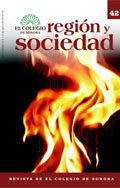 |
 |
 |
 |
 |
 |
 |
 |
 |
 |
 |
 |
Abstract
The concept of poverty is analyzed here, in a local community that lives within the boundaries of a protected natural area (PNA), using the methodological framework suggested by the Secretaría de Desarrollo Social [Ministry of Social Development] (SEDESOL, according to its Spanish initials), whose public policy establishes three categories for measuring poverty: food poverty, capacity poverty, and patrimonial poverty. We consider as a case study the Ejido San Jorge (ESJ) , located within the boundaries of the Reserva de la Biosfera Sierra La Laguna, in Baja California Sur. The analysis is based on information gathered through interviews with members of the community. Per capita income was used as criteria for defining if that income allows the person to cover basic needs. The results showed that the poverty in the area, between 2000 and 2004, did not change greatly The conclusion is that the population is poor, according to the own SEDESOL criteria, and that this condition has not improved despite living in a PNA. We discuss some alternatives to mitigate poverty conditions in the analyzed community.
References
Adams, W M., R. Aveling, D. Brockington, B. Dickson, J. Elliott, J. Hutton, D. Roe, B. Vira y W Wolmer. 2004. Biodiversity Conservation and the Eradication of Poverty. Science 306 (5699): 1146–1149.
Banco de México. 2005. Índice de precios al consumidor. http://www.banxico.org.mx/elInfoFinanciera/FSinfoFinanciera.html (10 de septiembre de 2005).
Barkin, David. 1998. Riqueza, pobreza y desarrollo sostenible. http://www.eumed.net/libros/2005/db/db.pdf (6 de julio de 2006).
Boltvinik, Julio. 2003. Conceptos y métodos para el estudio de la pobreza. Comercio Exterior 53 (5): 404–409.
–––––––––– y Araceli Damián. 2003. Derechos humanos y medición oficial de la pobreza en México. Papeles de Población (35): 101–137.
–––––––––– y Enrique Hernández Laos. 1999. Pobreza y distribución del ingreso en México. México: Siglo XXI.
Castorena, Lorena y Aurora Breceda Solís. 2003. Diagnóstico social y diseño de estrategia operativa para la Reserva de la Biosfera Sierra La Laguna. México: Secretaría del Medio Ambiente y Recursos Naturales (SEMARNAT), CONANP y Banco Mundial.
Comisión Nacional de Áreas Naturales Protegidas. 2003. Programa de manejo, Reserva de la Biosfera Sierra La Laguna. México: SEMARNAT y dirección de la REBISLA.
–––––––––– Áreas Naturales Protegidas. http://www.CONANP.gob.mx/anp/anp.php (9 de septiembre de 2007).
Cortés Cáceres E, D. Hernández, E. Hernández Laos, M. Székely Pardo y H. Vera Llamas. 2002a. Medición de la pobreza, variantes metodológicas y estimación preliminar. Serie: documentos de investigación, no. 1. México: CTMP–SEDESOL.
––––––––––. 2002b. Evolución y características de la pobreza en México en la última década del siglo XX. Serie: documentos de investigación, no. 2. México: CTMP–SEDESOL.
Desai, Meghnad. 2003. Pobreza y capacidades: hacia una medición empíricamente aplicable. Comercio Exterior 53 (5): 434–444.
Diario Oficial de la Federación. 1994. Norma Oficial Mexicana nom–059–ecol–1994, que determina el decreto de la creación de la Reserva de la Biósfera Sierra La Laguna, B. C. S., 6 de junio.
Gobierno del Estado de Baja California Sur, Secretaría de Promoción y Desarrollo Económico, Secretaría de Planeación e INEGI. 2002. Cuadernos estadísticos. México: Gobierno del Estado de Baja California Sur, Secretaría de Promoción y Desarrollo Económico, Secretaría de Planeación–INEGI.
Gray, L C. y W. G. Moseley 2005. A Geographical Perspective on Poverty–Environment Interactions. The Geographical Journal 171 (1): 9–23.
Hernández Laos, Enrique. 2001. Retos para la medición de la pobreza en México. Comercio Exterior 51 (10): 860–868.
La Jornada. 2002. La medición de la pobreza en México al año 2001. 4 de septiembre. http://www.jornada.unam.mx/2002/09/04/per–texto.html (27 de marzo de 2006).
Olmos–Martínez, Elizabeth. 2005. Hacia un desarrollo sustentable y caracterización de la pobreza en el ejido San Jorge, Reserva de la Biosfera Sierra La Laguna, B. C. S. Tesis de maestría en Economía del Medio Ambiente y de los Recursos Naturales, Universidad Autónoma de Baja California Sur.
Programa de las Naciones Unidas para el Desarrollo y Comisión Europea. 2000. Combatir la pobreza y mejorar al mismo tiempo el medio ambiente: opciones óptimas. Nueva York: PNUD y CE.
Roe, D. y J. Elliott. 2006: Pro–Poor Conservation: The Elusive Win–Win for Conservation and Poverty Reduction? Policy Matters 14: 53–63.
Scherr, S. J. 2000. A Downward Spiral? Research Evidence on the Relationship between Poverty and Natural Resource Degradation. Food Policy 25 (4): 479–498.
Sen, Amartya. 2003. El enfoque de las capacidades y las realizaciones. Comercio Exterior 53 (5): 413–416.
Open access policy
The authors who publish in región y sociedad accept the following conditions:
In accordance with the copyright laws, región y sociedad recognizes and respects the authors’ moral rights, as well as the ownership of property rights, which will be transferred to the journal to disseminate the articles in open access. región y sociedad does not charge the authors for submitting and processing articles for publication.
All the texts published by región y sociedad —with no exception— are distributed under a Creative Commons license 4.0 Attribution – Noncommercial (CC BY-NC 4.0 International), which allows third parties to use the publication as long as they mention the works’ authorship and the first publication in this journal.
The authors can enter into independent and additional contractual agreements for the nonexclusive distribution of the version of the article published in región y sociedad (for instance include it into an institutional repository or publish it in a book) as long as they clearly indicate that the work was published for the first time in región y sociedad.
For all the above, the author(s) must send the Letter of transfer of property rights of the first publication duly filled in and signed by the author(s). This letter can be sent by e-mail as a PDF to: region@colson.edu.mx






